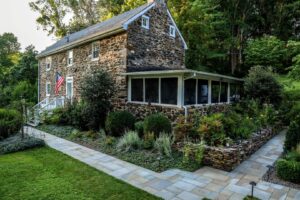
If you are ready to improve your landscaping, we have some tips for your next redesign.
Interest in gardening and landscaping has been making a comeback as homeowners look for ways to refresh their outdoor spaces and spend more time in nature. Do you want to add more color and improve your yard’s design? Creating a beautiful landscape involves understanding some key design elements. If you are ready to take your landscaping to the next level, we have some tips for your next redesign. Keep reading to learn more!
Have a Landscape Design Plan
It’s important to know the purpose of your landscape design. If you want more privacy, evergreens provide year-round coverage. If you plan to reduce energy costs, plant a shade tree on the south or west side of your house or shrubs on the north side to block winter winds. If you want to create a habitat for birds, butterflies, and other pollinators, incorporate plants to attract wildlife. Maybe you aim to create a focal point or add beauty and value to your garden. Whatever your purpose, it will guide you in narrowing down the components for your design.
Plant for All Seasons
Consider the visual interest your garden will provide throughout the year. Planting perennials and flowering shrubs with different bloom times is an excellent way to have color all year long. Plants that bloom in the winter, such as ornamental grasses, will give your garden structure in winter. A patio area or water feature can serve many purposes in a design. It can provide visual interest, fill an area difficult for plants to grow, or be a focal point in your design.
Incorporate More Than Just Plants
We tend to jump straight to the flowers when we think about landscaping. Landscaping is also about rocks, mulch, and other eye-catching additions. Landscaping stones, for example, can create visual interest and less demand for water. Hardscape elements such as patios, walkways, and retaining walls add structure and functionality to your property. Choose materials to complement your home’s exterior style and color scheme.
Plan for Growth
When using framing plants, it’s important to consider their size once fully grown. These plants are typically used to frame the garden or the house and will be the largest plants in your design. Planting them too close to pathways and other structures can throw off your design once they reach maturity. Allow for adequate space between plants, and consider how they will look once fully mature. This can prevent overcrowding and maintenance issues.
Don’t Forget About Maintenance
Routine maintenance is crucial for keeping your landscape looking its best. Develop a pruning, weeding, and watering routine to ensure your outdoor space is healthy and beautiful. Be sure to add mulch and topsoil as needed to protect your plants.
Questions? Lehnhoff’s Supply is Here to Help
If you still have more questions about landscape design, the trained professionals at Lehnhoff’s Supply are here to help you.
Find us at 2708 Belair Road, Fallston, MD 21047 and give us a call at 410-510-7646. For tips, tricks, and to see what we have been up to, be sure to follow us on Facebook, X – Twitter, and Pinterest!
We serve but aren’t limited to, the following parts of Maryland: Harford County – Fallston, Forest Hill, Joppa, Edgewood, Bel Air, Churchville, Havre de Grace, Jarrettsville, Street, Aberdeen, Abingdon, and Joppatowne. In Baltimore County: Kingsville, Perry Hall, Overlea, Fullerton, Nottingham, Parkville, Towson, Carney, Loch Raven, Lutherville, Timonium, Hunt Valley, Cockeysville, Sparks, Glyndon, Pikesville, Reisterstown, Ruxton, Parkton, Glen Arm, Baldwin, Monkton, Long Green, White Marsh, Rosedale, Phoenix, and Fork.
